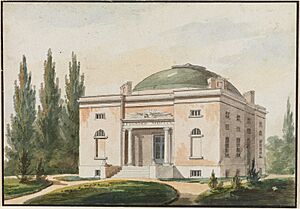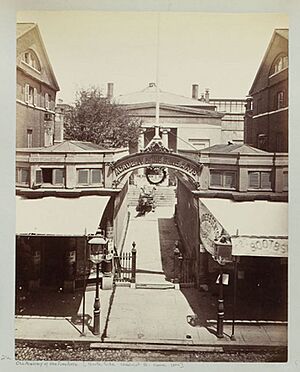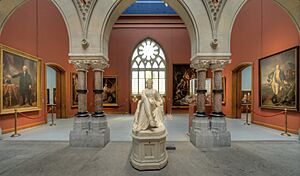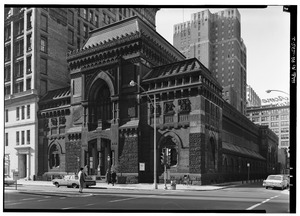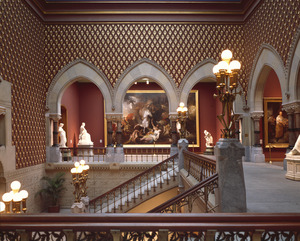Pennsylvania Academy of the Fine Arts facts for kids
|
Pennsylvania Academy of the Fine Arts
|
|
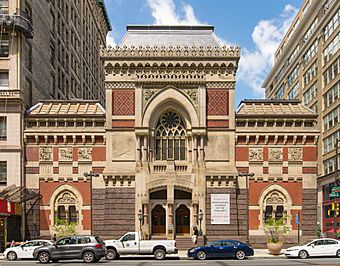
The Pennsylvania Academy of Fine Arts in Center City Philadelphia
|
|
| Lua error in Module:Location_map at line 420: attempt to index field 'wikibase' (a nil value). | |
| Location | 118-128 North Broad Street, Philadelphia, Pennsylvania, U.S. |
|---|---|
| Built | 1871–1876 |
| Architect | Frank Furness; George Hewitt |
| Architectural style | Second Empire, Renaissance, Gothic |
| Website | www.pafa.org |
| NRHP reference No. | 71000731 |
Quick facts for kids Significant dates |
|
| Added to NRHP | May 27, 1971 |
| Designated NHL | May 15, 1975 |
The Pennsylvania Academy of the Fine Arts (PAFA) is a special place in Philadelphia, Pennsylvania. It is both a museum and a private art school. PAFA was started in 1805. This makes it the oldest art museum and art school in the United States that has been open continuously since it began.
The museum at PAFA is famous around the world. It has amazing collections of American paintings, sculptures, and drawings from the 1800s and 1900s. Its historical records are also very important for learning about American art history. PAFA offers different art programs. These include a Bachelor of Fine Arts degree and certificate programs. Since 2025, PAFA has focused its degree programs on a partnership with the University of Pennsylvania.
Contents
History of PAFA
The 1800s: Early Years and Growth
The Pennsylvania Academy of the Fine Arts was started in 1805. Key founders included the painter and scientist Charles Willson Peale and sculptor William Rush. Other artists and business leaders also helped. PAFA's first building opened in 1806 on Chestnut Street in Center City Philadelphia.
The academy opened as a museum in 1807. Its first art show was in 1811, displaying over 500 paintings and statues. Art classes began in the building in 1810.
A fire in 1845 destroyed the first building. A new one opened in 1847 but was damaged by a storm and taken down in 1870. The leaders then raised money for a grander building. They hired architects Frank Furness and George Hewitt. The current Furness-Hewitt building was built starting in 1871. It opened in 1876 as part of the 1876 Philadelphia Exposition.
In 1876, a former student named Thomas Eakins returned to teach. He became a faculty member in 1878 and director in 1882. Eakins changed the art program. Students learned drawing, painting, sculpture, and printmaking for two years. Then, they did independent projects with guidance from teachers and other artists.
PAFA slowly started including women artists more. In 1844, women artists could use the statue gallery. By 1860, female students could take anatomy classes. They could also draw from antique statues and use the library. In 1868, women were allowed to draw from female nude models. Six years later, they could draw from male models too, after much discussion.
In 1878, Catherine Drinker became the first woman to teach at PAFA. Later, in 1895, her cousin Cecilia Beaux became the first female faculty member to teach painting and drawing.
The 1900s: New Art and Leaders
From 1890 to 1906, Edward Hornor Coates was the president of PAFA. He helped the academy grow a lot. During his time, PAFA received many gifts of money for the schools. A collection of national portraits was also started. Some of the best works by Gilbert Stuart were bought.
The yearly art shows became very popular. Coates helped keep the art schools focused on traditional art. He was supported by famous artists like Eakins and Chase. Coates was known for his kindness and dedication to PAFA. He worked hard to make the academy famous for its art.
Harrison S. Morris, who managed PAFA from 1892 to 1905, collected modern American art. Many famous artworks were bought during his time. These included pieces by Cecilia Beaux, William Merritt Chase, Thomas Eakins, and Winslow Homer. Works by "The Eight" artists, like Robert Henri and John Sloan, showed a shift in art styles.
The 2000s: Modern Collections and Changes
In 2010, PAFA received the Linda Lee Alter Collection of Art by Women. This collection has almost 500 artworks by female artists. It includes pieces by Louise Bourgeois, Judy Chicago, and Kara Walker. In 2012, PAFA showed this collection in an exhibition called The Female Gaze: Women Artists Making Their World.
How PAFA Works

The Museum
Since it started, PAFA has collected art by important American artists. It also collects works by its talented former students and teachers. Today, PAFA continues to collect art by modern and contemporary American artists.
The museum shows both historical and modern art. It also features art by local artists and has yearly shows of student work. The art collection is arranged to show the history of American art from the 1760s to today.
The School
PAFA has a long-running four-year certificate program. Since 1929, students could also get a Bachelor of Fine Arts degree through a program with the University of Pennsylvania. PAFA also offered its own BFA and a Master of Fine Arts degree.
In 2005, PAFA received the National Medal of Arts. This award recognized its important role in art education in the country.
In 2007, PAFA and the Philadelphia Museum of Art bought The Gross Clinic by Thomas Eakins. This famous painting is shown at both museums on a rotating basis.
PAFA has agreements with several community colleges. These agreements make it easier for students to transfer art and liberal arts classes to PAFA. This helps more students continue their art education.
In 2013, PAFA received accreditation from the Middle States Commission on Higher Education. This means its programs meet high educational standards.
In 2024, PAFA announced changes to its degree programs. Since 2025, PAFA has no longer offered its own BFA or MFA degrees. However, it still offers continuing education, certificate programs, and the bachelor's degree in partnership with the University of Pennsylvania.
PAFA Buildings
The Furness-Hewitt Building
The main museum building, known as the Furness-Hewitt building, began construction in 1871. It opened in 1876 for the Philadelphia Centennial. It was designed by American architects Frank Furness and George Hewitt. Many people call it "One of the most magnificent Victorian buildings in the country."
The outside of the building mixes different historical styles. These include Second Empire, Renaissance Revival, and Gothic Revival. The building uses many colors of stone and brick. It was the first building in the U.S. made specifically for teaching and showing fine arts all in one place.
The inside of the building is also very colorful and varied. It has gold patterns, a blue ceiling with silver stars, and gallery walls in plum, ochre, and olive green. The building uses brick, stone, and iron. Some iron beams were left uncovered to help prevent fires.
The Furness-Hewitt building is now considered one of the most important buildings in Philadelphia. It is one of Furness's greatest works. In 1971, it was added to the National Register of Historic Places. In 1975, it was named a National Historic Landmark.
In 1976, the building was restored inside and out. This was done for its 100th birthday and the United States' 200th birthday. Another renovation was completed in 2019 by DLR Group. This helped the building handle more visitors while keeping its historic look.
The Samuel M.V. Hamilton Building
In 2002, Dorrance H. Hamilton gave a large gift to PAFA for its expansion. PAFA then bought a building next to the original one. This building was once an automobile factory and later a government building. It was renamed the Samuel M.V. Hamilton building in memory of her husband. PAFA finished moving into this new building in September 2006.
The Hamilton building has an exhibition space called the Fisher Brooks Gallery. It also houses Portfolio, which is the museum's gift shop.
Awards from PAFA
PAFA has given out several awards to artists over the years.
- Widener Gold Medal: This award for sculpture was started in 1912. It honors the best sculpture by an American artist shown at PAFA's yearly exhibition.
Past Awards
- Beck Gold Medal: This award was given for the best portrait by an American artist. It was awarded from 1909 to 1968.
- Mary Smith Prize: This prize was for the best painting by a woman artist living in the area. It was awarded from 1879 to 1968.
- Temple Gold Medal: This award was for the best oil painting by an American artist. It was given from 1883 to 1968.
Notable People
See also
 In Spanish: Academia de Bellas Artes de Pensilvania para niños
In Spanish: Academia de Bellas Artes de Pensilvania para niños


